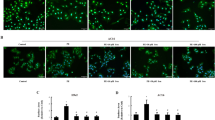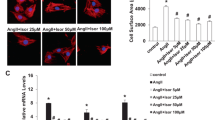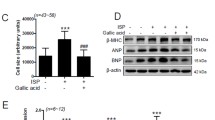Abstract
Scutellarin is a flavonoid extracted from a traditional Chinese herb, Erigeron breviscapus Hand Mazz, which has been broadly used in treating various cardiovascular diseases. In this study, we investigated its effect on cardiac hypertrophy and the underlying mechanism. Both in vitro and in vivo cardiac hypertrophy models were employed to explore the anti-hypertrophic action of scutellarin. We found that scutellarin significantly suppressed the hypertrophic growth of neonatal cardiac myocytes exposed to phenylephrine (PE) and mouse heart subjected to pressure overload induced by aortic banding, accompanied with the decreased expression of hypertrophic markers β-myosin heavy chain and atrial natriuretic peptide. We then measured the change of free intracellular calcium using laser scanning confocal microscope. We found that scutellarin alleviated the increment of free intracellular calcium during cardiac hypertrophy either induced by PE or aortic banding. The expression of calcium downstream effectors calcineurin and phosphorylated calmodulin kinase II (CaMKII) were significantly suppressed by scutellarin. Our study indicated that scutellarin exerts its anti-hypertrophic activity via suppressing the Ca2+-mediated calcineurin and CaMKII pathways, which supports the observation that clinical application of scutellarin is beneficial for cardiovascular disease patients.






Similar content being viewed by others
References
Barry SP, Davidson SM, Townsend PA (2008) Molecular regulation of cardiac hypertrophy. Int J Biochem Cell Biol 40:2023–2039
Bers DM, Guo T (2005) Calcium signaling in cardiac ventricular myocytes. Ann N Y Acad Sci 1047:86–98
Chan AY, Dolinsky VW, Soltys CL, Viollet B, Baksh S, Light PE, Dyck JR (2008) Resveratrol inhibits cardiac hypertrophy via AMP-activated protein kinase and Akt. J Biol Chem 283:24194–24201
Cingolani E, Ramirez Correa GA, Kizana E, Murata M, Cho HC, Marban E (2007) Gene therapy to inhibit the calcium channel beta subunit: physiological consequences and pathophysiological effects in models of cardiac hypertrophy. Circ Res 101:166–175
Han JJ, Hao J, Kim CH, Hong JS, Ahn HY, Lee YS (2009) Quercetin prevents cardiac hypertrophy induced by pressure overload in rats. J Vet Med Sci 71:737–743
Heineke J, Molkentin JD (2006) Regulation of cardiac hypertrophy by intracellular signalling pathways. Nat Rev Mol Cell Biol 7:589–600
Kato T, Sano M, Miyoshi S, Sato T, Hakuno D, Ishida H, Kinoshita-Nakazawa H, Fukuda K, Ogawa S (2000) Calmodulin kinases II and IV and calcineurin are involved in leukemia inhibitory factor-induced cardiac hypertrophy in rats. Circ Res 87:937–945
Klee CB, Ren H, Wang X (1998) Regulation of the calmodulin-stimulated protein phosphatase, calcineurin. J Biol Chem 273:13367–13370
Klein L, O'Connor CM, Gattis WA, Zampino M, de Luca L, Vitarelli A, Fedele F, Gheorghiade M (2003) Pharmacologic therapy for patients with chronic heart failure and reduced systolic function: review of trials and practical considerations. Am J Cardiol 91:18F–40F
Latronico MV, Elia L, Condorelli G, Catalucci D (2008) Heart failure: targeting transcriptional and post-transcriptional control mechanisms of hypertrophy for treatment. Int J Biochem Cell Biol 40:1643–1648
Lee KS, Park JH, Lee S, Lim HJ, Park HY (2009) PPARdelta activation inhibits angiotensin II induced cardiomyocyte hypertrophy by suppressing intracellular Ca2+ signaling pathway. J Cell Biochem 106:823–834
Levy D, Garrison RJ, Savage DD, Kannel WB, Castelli WP (1990) Prognostic implications of echocardiographically determined left ventricular mass in the Framingham Heart Study. N Engl J Med 322:1561–1566
Li HL, Huang Y, Zhang CN, Liu G, Wei YS, Wang AB, Liu YQ, Hui RT, Wei C, Williams GM, Liu DP, Liang CC (2006) Epigallocathechin-3 gallate inhibits cardiac hypertrophy through blocking reactive oxidative species-dependent and -independent signal pathways. Free Radic Biol Med 40:1756–1775
Li XL, Li YQ, Yan WM, Li HY, Xu H, Zheng XX, Guo DW, Tang LK (2004) A study of the cardioprotective effect of breviscapine during hypoxia of cardiomyocytes. Planta Med 70:1039–1044
Liao Y, Ishikura F, Beppu S, Asakura M, Takashima S, Asanuma H, Sanada S, Kim J, Ogita H, Kuzuya T, Node K, Kitakaze M, Hori M (2002) Echocardiographic assessment of LV hypertrophy and function in aortic-banded mice: necropsy validation. Am J Physiol Heart Circ Physiol 282:H1703–H1708
Lips DJ, deWindt LJ, van Kraaij DJ, Doevendans PA (2003) Molecular determinants of myocardial hypertrophy and failure: alternative pathways for beneficial and maladaptive hypertrophy. Eur Heart J 24:883–896
Molkentin JD, Lu JR, Antos CL, Markham B, Richardson J, Robbins J, Grant SR, Olson EN (1998) A calcineurin-dependent transcriptional pathway for cardiac hypertrophy. Cell 93:215–228
Pan Z, Feng T, Shan L, Cai B, Chu W, Niu H, Lu Y, Yang B (2008) Scutellarin-induced endothelium-independent relaxation in rat aorta. Phytother Res 22:1428–1433
Prasad AM, Inesi G (2009) Effects of thapsigargin and phenylephrine on calcineurin and protein kinase C signaling functions in cardiac myocytes. Am J Physiol Cell Physiol 296:C992–C1002
Rupp H, Elimban V, Dhalla NS (1992) Modification of subcellular organelles in pressure-overloaded heart by etomoxir, a carnitine palmitoyltransferase I inhibitor. FASEB J 6:2349–2353
Wang M, Zhang WB, Zhu JH, Fu GS, Zhou BQ (2009) Breviscapine ameliorates hypertrophy of cardiomyocytes induced by high glucose in diabetic rats via the PKC signaling pathway. Acta Pharmacol Sin 30:1081–1091
Wilkins BJ, Molkentin JD (2004) Calcium-calcineurin signaling in the regulation of cardiac hypertrophy. Biochem Biophys Res Commun 322:1178–1191
Yang B, Lin H, Xiao J, Lu Y, Luo X, Li B, Zhang Y, Xu C, Bai Y, Wang H, Chen G, Wang Z (2007) The muscle-specific microRNA miR-1 regulates cardiac arrhythmogenic potential by targeting GJA1 and KCNJ2. Nat Med 13:486–491
Zhang T, Brown JH (2004) Role of Ca2+/calmodulin-dependent protein kinase II in cardiac hypertrophy and heart failure. Cardiovasc Res 63:476–486
Zhang T, Johnson EN, Gu Y, Morissette MR, Sah VP, Gigena MS, Belke DD, Dillmann WH, Rogers TB, Schulman H, Ross J Jr, Brown JH (2002) The cardiac-specific nuclear delta(B) isoform of Ca2+/calmodulin-dependent protein kinase II induces hypertrophy and dilated cardiomyopathy associated with increased protein phosphatase 2A activity. J Biol Chem 277:1261–1267
Zhu W, Zou Y, Shiojima I, Kudoh S, Aikawa R, Hayashi D, Mizukami M, Toko H, Shibasaki F, Yazaki Y, Nagai R, Komuro I (2000) Ca2+/calmodulin-dependent kinase II and calcineurin play critical roles in endothelin-1-induced cardiomyocyte hypertrophy. J Biol Chem 275:15239–15245
Acknowledgements
This work was supported by the China Postdoctoral Science Foundation (to Zhen-Wei Pan), the National Natural Science Foundation of China (Grant No. 30971252; to Yan-Jie Lu), and the National Basic Research Program of China (973 Program; 2007CB512000/2007CB512006; to Bao-Feng Yang).
Author information
Authors and Affiliations
Corresponding authors
Additional information
Zhen-Wei Pan and Ying Zhang have equal contributions to the work.
Rights and permissions
About this article
Cite this article
Pan, ZW., Zhang, Y., Mei, DH. et al. Scutellarin exerts its anti-hypertrophic effects via suppressing the Ca2+-mediated calcineurin and CaMKII signaling pathways. Naunyn-Schmied Arch Pharmacol 381, 137–145 (2010). https://doi.org/10.1007/s00210-009-0484-y
Received:
Accepted:
Published:
Issue Date:
DOI: https://doi.org/10.1007/s00210-009-0484-y




